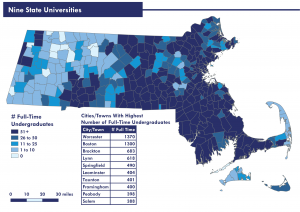Case Study
Massachusetts State College Building Authority
Boston, Massachusetts

Strategic Plans: 2014, 2016, 2018, 2020
Demographic Perspectives has worked with the Massachusetts State College Building Authority (MSCBA), the Boston-based authority overseeing the nine State Universities, since 2014 preparing biennial Strategic Plans to inform the MSCBA’s strategic decision-making.
DP finalized comprehensive Strategic Plans in 2014, 2016, 2018 and 2020. Each 300-page report, including 200+ figures, provided an in-depth view of each of the State Universities plus a system-wide analysis. Our work has included enrollment and occupancy projections for the MSCBA strategic plan, and DP incorporated occupancy management methodology and diversity, equity, and inclusion criteria into the most recent plan of 2020.
Stakeholder Input
For each Strategic Plan, DP worked closely with the Offices of Institutional Research and Housing at the nine State Universities. As part of the process, DP conducted interviews with the Presidents and other officials at each of the State Universities. Leadership at each school spoke with us about the importance of housing and residential life programs to their campus goals for diversity and freshmen to sophomore retention. These conversations provided quantitative and qualitative data on both housing and residential life at each school.
Housing Inventory Analysis
The Strategic Plans focus on the strategic direction for housing and other student activity projects at each school, as informed by their academic agendas, enrollment patterns, and campus layout and building portfolios. The report also provides a description of recent, current, and anticipated MSCBA projects for each school.
 Demographic Analysis
Demographic Analysis
DP analyzed demographic trends in the Northeast and specifically, in Massachusetts (from sources including the Massachusetts Department of Education and Department of Higher Education, and the University of Massachusetts Donahue Institute), including high school graduation levels, plans for college, and population projections. DP also used GIS mapping of student addresses to evaluate their locations in relation to the campuses.
Market Research
To project demand for MSCBA housing into the next decade and to determine whether the MSCBA was meeting its goals of housing UG students on campus, DP compared MSCBA rates for on-campus housing for each school to a wide range of peer school campus housing rates, and to the local private residential rental market.
For the 2020 Strategic Plan Update, DP analyzed the under-represented populations who were people of color or first generation at each of the state. The percent of undergraduates at the State Universities in these categories has risen over time though the percentage also varies by campus. At one campus, DP piloted a project to conduct focus groups with under-represented populations in order to ensure that their needs and preferences were being considered in housing and residential life planning.
In 2020, DP incorporated occupancy management tools into the Strategic Plan which allow Universities to maximize efficiency and savings with a goal of enhancing the performance of student housing. Dramatic demographic shifts, changes in international student attendance, and the impact of the COVID pandemic all need to be considered as the MSCBA projects housing demand. Occupancy management skills and tools can assist those engaged in the strategic planning process to set priorities, focus energy and resources, and strengthen operations. Merging occupancy management data and the impact that it may have on housing policies in this report, DP presented the analysis and findings to MSCBA Trustees and senior administrators of each university. DP also worked with university staff in a wide range of offices, including Admissions, Enrollment Management, Financial Aid, Student Services, Housing, and Auxiliary Services, to ensure that they would have the tools to create occupancy management models which can then be used to determine the impact of current or new strategies.
Actionable Outcomes
- Provided the MSCBA with a comprehensive overview of current and planned housing on each of the nine campuses
- To inform strategic decision-making, described how institutional mission and academic goals of each school could be met through housing
- To assist the MSCBA in setting housing rates, measured each university’s housing rental rates against local private market rentals and peer institutions
- To show that the MSCBA was on track to meet its housing goals for full-time undergraduate students, modeled varying population levels in future years
- Provided each campus with a playbook of data for occupancy management strategies
- Using analysis and projections, concluded that because of the demographic decline and the effect of COVID, MSCBA should be cautious in planning housing at this time
To learn more about this case study, contact Demographic Perspectives today.

